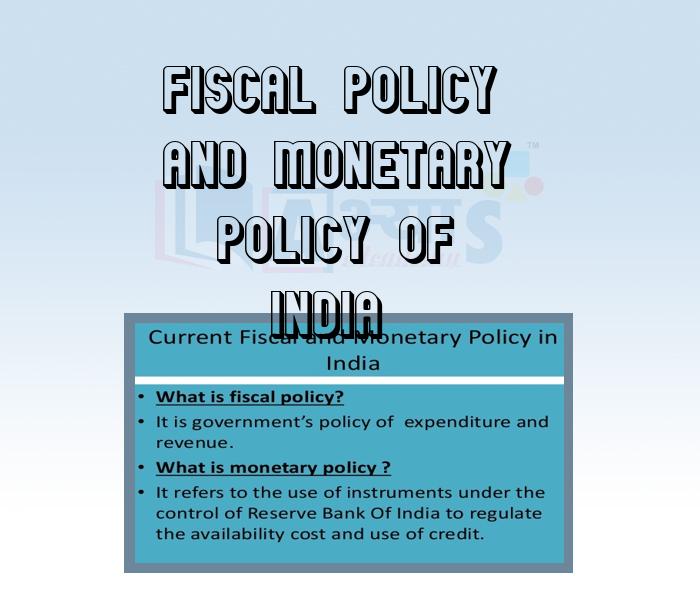Fiscal Policy And Monetary Policy Of India











Fiscal Policy And Monetary Policy Of India
Fiscal Policy and Monetary Policy of India: Fiscal Policy is the main part of Economic Policy. Fiscal Policy's first word Fiscal is taken from French word "Fisc"; it means treasure of Government. Therefore, we can define_fiscal policy as the revenue and expenditure policy of Government of India. It is prime duty of Government to make fiscal policy. By making this policy, Government collects money from different resources and utilises it in different expenditure. Thus, fiscal policy is related to development policy. All welfare projects are completed under this policy.Objectives of Fiscal Policy: There are following objectives of fiscal policy:
1. Development of Country
2. Employment
3. Removal of Inequality
4. Fixation of Govt. ResponsibilityEffective use of resources is the duty of the Government, and by making of fiscal policy, different minister's accountability can be checked.
Techniques of Fiscal Policy:
1. Taxation Policy: Government of India passes finance bill every year. In this bill, the government determines the rate of taxes. It can increase or decrease these tax rates and amend previous rules of taxation. The main source of government's earnings is taxation. However, more tax on public will adversely affect the development of economy.
2. Expenditure Policy: Large public expenditure is involved in opening of govi schools, colleges and universities, making ofbridges, roads and new railway tracks, All this expenditure is based on government's expenditure policy. Government can inerease or decrease the amount of public expenditure by changing the budget.3. Deficit Financing: If Government's expenditure is more than its revenue, it bridges this deficit through borrowings from central bank of country. But, deficit financing will reduce the purchasing power of currency. More new currency will increase inflation.
4. Public Debt Policy: Government can take loan trom worla bank of trom public by issuing government securities andbonds. But it will also increase the cost of debt m the fom of iterest, which government has to pay on the amount of loan,
Limitations of Fiscal Policy:
1. Inflation in India is increasing rapidly and living of poor person has become difficult. This shows the failure of Indian fiscal policy.
2. Government fiscal policy has failed to reduce the black money.
3. Loans from World Bank imply that government has to obey the rules and regulations of World Bank and IMF.
4. Rate of unemployment is increasing fast
Students / Parents Reviews [10]
My experience with Abhyas is very good. I have learnt many things here like vedic maths and reasoning also. Teachers here first take our doubts and then there are assignments to verify our weak points.

Shivam Rana
7thOne of the best institutes to develope a child interest in studies.Provides SST and English knowledge also unlike other institutes. Teachers are co operative and friendly online tests andPPT develope practical knowledge also.

Aman Kumar Shrivastava
10thIt has a great methodology. Students here can get analysis to their test quickly.We can learn easily through PPTs and the testing methods are good. We know that where we have to practice

Barkha Arora
10thAbhyas is a complete education Institute. Here extreme care is taken by teacher with the help of regular exam. Extra classes also conducted by the institute, if the student is weak.

Om Umang
10thAbhyas Methodology is very good. It is based on according to student and each child manages accordingly to its properly. Methodology has improved the abilities of students to shine them in future.

Manish Kumar
10thIt was good as the experience because as we had come here we had been improved in a such envirnment created here.Extra is taught which is beneficial for future.

Eshan Arora
8thIt was a good experience with Abhyas Academy. I even faced problems in starting but slowly and steadily overcomed. Especially reasoning classes helped me a lot.

Cheshta
10thBeing a parent, I saw my daughter improvement in her studies by seeing a good result in all day to day compititive exam TMO, NSO, IEO etc and as well as studies. I have got a fruitful result from my daughter.

Prisha Gupta
8thA marvelous experience with Abhyas. I am glad to share that my ward has achieved more than enough at the Ambala ABHYAS centre. Years have passed on and more and more he has gained. May the centre flourish and develop day by day by the grace of God.

Archit Segal
7thAbout Abhyas metholodology the teachers are very nice and hardworking toward students.The Centre Head Mrs Anu Sethi is also a brilliant teacher.Abhyas has taught me how to overcome problems and has always taken my doubts and suppoeted me.
